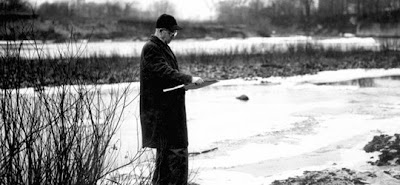If Watercolor Doesn't Kill You It Will Make You Stronger, Part III: Charles Burchfield
Charles Burchfield drawing out of doors in the winter near Buffalo, NY
(All these images are courtesy the Burchfield Penney Art Center, Buffalo, NY).
Last week I was the featured speaker at the Baltimore Watercolor Society's Annual Dinner. We had a great audience of 80 some people. I showed watercolors by Winslow Homer, Edward Hopper (OK, no surprise there) and Charles Burchfield.
I saved Burchfield for last as I suspected he was the least well known of the three. Several people approached me after the talk to say they'd never seen Burchfield's work before and wanted to know where to go to see more. (I recommend the Burchfield Penney Art Center's website which is where I obtained these images).
Deserted Miner's Home, 1918 Burchfield Penney Art Center
In his spooky Deserted Miner's Home the house and barn seem to almost scream out at us through gaping mouths. Yet nearly nightmarish drama is counter posed to an almost monochrome restraint throughout the rest of the painting. Burchfield is almost always like this- offering us something nearly over the top in each painting but always stopping just short of overdoing it. He is a master of balancing the conflicting needs for drama and for stability and making things plausible.
Charles Burchfield, Marshy Meadows, 1916, Burchfield Penney Art Center
His watercolor Sleet Storm below is typically for Burchfield chock full of rooftops, snowdrifts and seemingly innumerable little branches. There is a constant artful adjustment going on through the painting as the artist kept changing the color of his trees, from black trunks, to a whole range of mid grey to white little branches. Think how overloaded the painting would have felt if he'd stayed with all dark tones for the trees. Once again, elegant restraint.
Charles Burchfield, Sleet Storm, 1920, Burchfield Penney Art Center
Here's a totally wild painting from later in Burchfield's life.
Charles Burchfield, Wind Blown Asters, 1951, Burchfield
Penney Art Center
Populating his foreground are the most fantastical assortment of blossoms, butterfly wings and profoundly strange eye-like calligraphy at the left. It seems almost a menagerie.
But behind all this chaos a much more peaceful middle ground space restores peace to the picture. And the far distance is an expanse of unruffled smooth washes. In many ways spatially it's a very traditional panorama, but with Burchfield's signature imagination in full swing.
Unlike most watercolorists, Burchfield preferred to work in the studio with his paintings held vertically on an easel instead of laying them down nearly horizontal. When one sees his work in person one is struck that he mostly used a well-loaded brush to accomplish big free-flowing strokes. Curiously he almost never has accidental drips of color falling across his paintings. He had his brush handling down pat.
Below is an unfinished piece by the artist where he cut an earlier painting in half and was in the process of adding an additional panel to it at the left.
Charles Burchfield, Easter Morning in the Wood, Right Side,
Burchfield Penny Art Center
In the artist's day watercolors were modestly scaled things- rarely over 20" or so in width. Burchfield changed that. He loved nothing better than revisiting earlier watercolors by fixing adjoining sheets of paper to them, expanding their scale sometimes to the 40" or even 60".
A consummate craftsman, he developed a technique of using a mat cutting tool to cut diagonal beveled edges on his sheets of watercolor paper so they could smoothly lie over and under each other. You have to stand very close to one of his watercolors to see just where these seams are.









